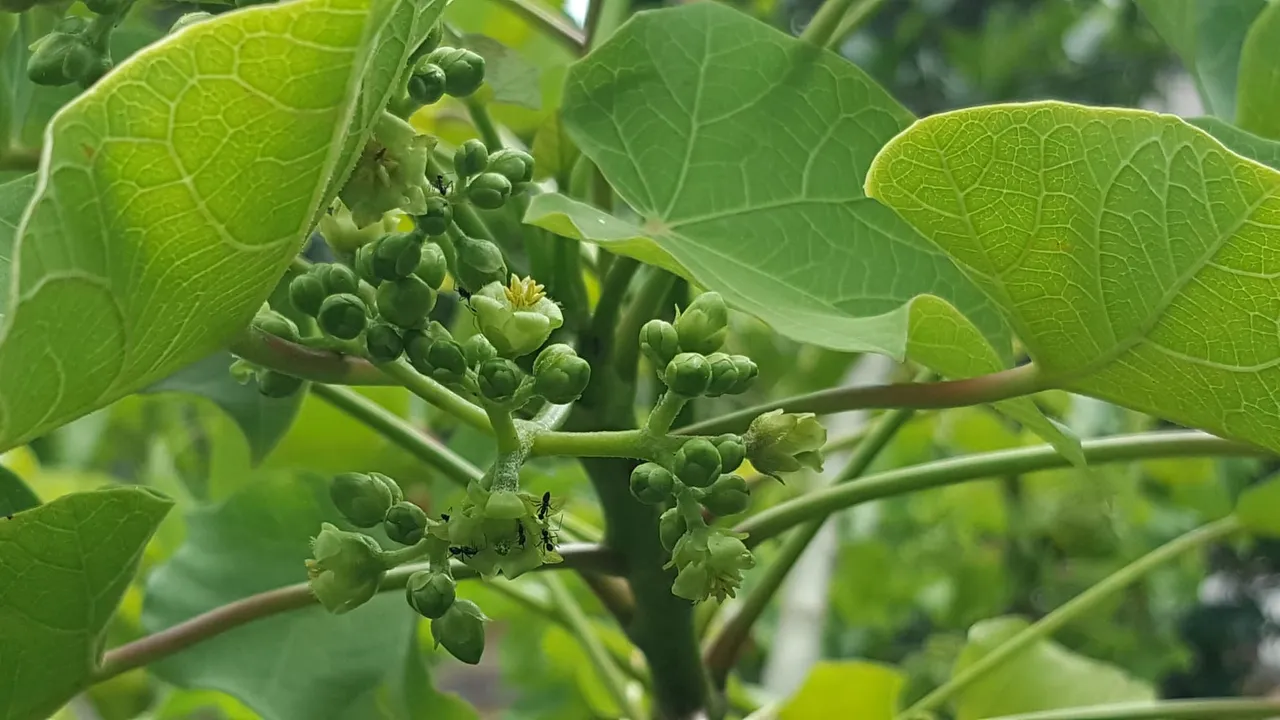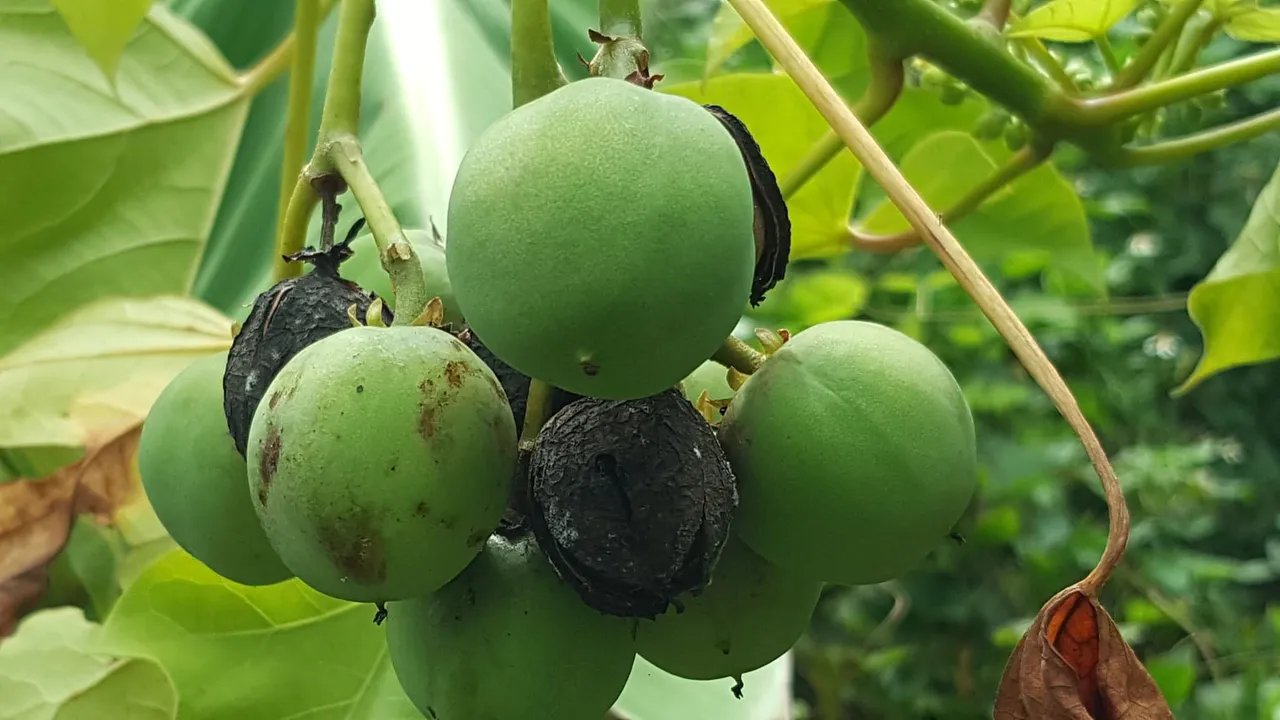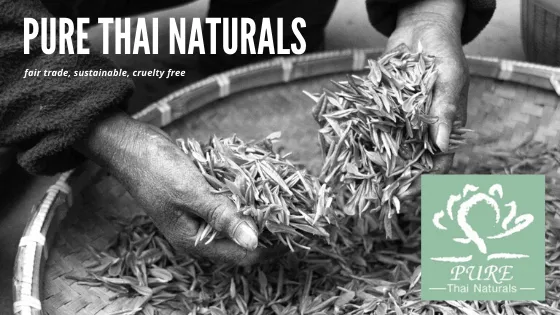Product development at Pure Thai Natural Co Ltd takes time - actually YEARS - because before we can even begin to play with product formulas and packaging, we have to be VERY SURE we will have a steady, local, organic supply of raw materials.
It was to that end that I planted some local "soap nut" seeds 3 years ago. Knowing full well that differentiating ourselves from toxic, GMO, big-agro-farmed, oil-based so-called "vegan" products is very much in our long term future.
This week we took a step closer as our first experimental "soap nut" tree broke into its first fruit.


This, my friends, is called Sabu Dam สบู่ดำ - botanically Jatropha curcas. Like oh so many "Thai" plants, it's not remotely indigenous to Thailand (or even Asia) but has been growing happily here for so long that only dreary old westerners who read too much even know that. "Sabu dam" in Thai means black soap.
Western people mostly only know the Chinese soap berries, Sapindus Mukorossi and Sapindus Trifoliatus, which are related to the lychee fruit and yes, also grow easily and well here in Thailand. We have plans for them too. 😊 But Sabu Dam is of particular interest because it is so much more than "only" a soap nut.
Indigenous to Africa and found extensively across South America, Sabu Dam thrives on neglect. Hence my experiment. I plonked my seedling in a ceramic pot in the middle of my Thai garden and ignored it. No water at all, no food, no soil. For 2 whole years. What happened? It's roots broke through the terracotta pot and shattered it 😍, sank themselves deep into the soil and my tree is literally blooming, fruiting and thriving in situ - competing with the mango tree and two mulberries close by and looking not remotely perturbed. Today, my "experiment" stands close to 4 meters tall 😍 and is bearing fruit. A surprising amount of fruit.

What's so special about THIS type of soap nut, as per the regular Chinese Sapindus variety?
Firstly, animals leave it alone. Which means the free ranging goats around the Muslim settlements along the Thai border camps will eat something else. Why don't they eat Sabu Dam? The leaves carry a large number of phytochemcials - not only the soapy-saponins but a sticky toxic latex that animals just know is not for them. Jatropha curcas is often grown as a living organic fence to keep other animals away from devouring crops. This is good news for our young moringa trees, which the goats destroyed-enjoyed.
It's seriously drought tolerant. In mountainous regions with no water AT ALL for up to 6 months of every year, whatever we plant has to thrive on A level neglect.
Although it is poisonous, the Jatropha curcas plant has many attributes, multiple uses and considerable potential. Bees frequent its flowers for nectar and pollen grains for their honey production. The wood is used for numerous purposes including fuel and as a building material. One particular importance is the use of its viscous seed oil in soap-making, the cosmetics industry and as a source of fuel for lighting.
Jatropha curcas is used as an ornamental plant and found in many homes. The plant is a rich source of many natural products most of which have been extensively used for human welfare especially in the treatment of various diseases. Source.
This is an important tree for our refugee bee-keeping project!!
The healing attributes of this simple "soap nut" can't be understated. This is the SHORT version:
The seed oil is used in the treatment and management of various conditions like arthritis, gout, eczema, skin diseases, rheumatic pain, jaundice, burns, inflammation, gonorrhoea, and as an abortifacient.
The leaf infusion or decoction of Jatropha curcas is administered for treatment of vaginal bleeding conditions in many communities and is also used both internally and externally to treat fever and jaundice. Rheumatic conditions are treated and managed by the external application of the leaf decoction or by massaging the affected joint-part using the juice/sap extract from the fresh leaves. The leaf decoction is also taken to treat malaria, mouth infections, guinea worm sores, as well as the treatment of dysentery and colic conditions. Furthermore, the leaf of Jatropha curcas is used to increase the milk supply in lactating mothers. In this scenario, 3–4 freshly harvested leaves are heated over fire and bandaged on the breast for a specified duration. The fresh or dried Jatropha curcas leaf is ground and made into a paste and then applied topically for the treatment of skin abscess. Source.
Dried mature seeds of the Sabu Dam tree have an oil content of close to 60%!
The bark of the stems produces a rich, natural blue dye and will be useful in other eco-textile projects. It is the colour of indigo, but easier to work with and available all year round.
In some parts of Africa, Jatropha is grown as an alternative source of bio-fuel.
My primary interest in this plant, commercially, is for making medicinal vegan soaps, since the Jatropha oil is reputed to be sheer magic for eczema, psoriasis and super-sensitive skin.
Once the oil is pressed, it DOES need to be treated to remove the toxic phorbol esters - we don't want whatever keeps animals from eating it to seep into your bloodstream via your skin. Thankfully there has been LOADS of research on how to do this, and it can be done quite simply by exposing the ground seed meal to sodium bicarbonate solution and ozone - both of which can be done very cost effectively using a small solar battery powered set up. Once the seed meal has been treated to neutralize the phorbol esters, the oil which is pressed is safe for consumption and ingestion. In our book, that also means it's now safe for your skin.
In an increasingly arid world with more and more oil sources mono-cropped and contaminated by GMOs, I am passionate about developing safe, fair trade and sustainable vegetable oil sources for the future - for soaps and natural shampoos, and for healthful ingestion. Sacha Inchi already is growing well in the northern Thai border regions, as are avocados and hemp. None of of them, including the Sabu dam, require en masse large scale destructive mono-cropping, and they all actually thrive on the edges of natural jungle and forest.
Can't tell you how HAPPY it makes me to see this tree fruiting well. Every single one of those seeds will be going in a pot, to create another tree.
And so it begins.
Loving the journey. BlissednBlessed. Thankful.

Get Your FREE Hive Account

Visit our online store here

Join The Best Natural Health Community on Hive
